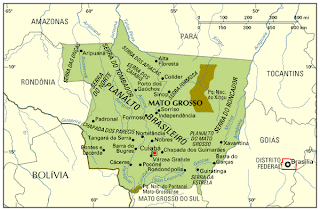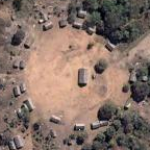 In the forests Brazil, live a host of peoples all speak the dialects of Gê language family, Bororo is one of them in the central of Mato Grosso.
In the forests Brazil, live a host of peoples all speak the dialects of Gê language family, Bororo is one of them in the central of Mato Grosso.It was generally considered by most anthropologists in early years that, the technological sophistication is the measure of the complexity of a society, however, another school argued that from the biological standpoint, every human culture has the similar mental capability, whether the advancement is manifested through technology is not a definite sign of genetic superiority, but rather cultural choices made along historical circumstances. This viewpoint is shown through the discovery of Gê peoples in Brazil, where there is stark difference between their primitiveness in the sense of technology, and the complex and sophisticated world views, this phenomenon is hence called Gê Anomaly.
The social structure of Bororo is complex where each community is divided into moieties. Each moiety is again divided into several matrilineal sibs, which are further subdivided into several
 matrilineages. Each sib is entitled to some special rights and privileges, for example, certain names, designs, knowledges etc.
matrilineages. Each sib is entitled to some special rights and privileges, for example, certain names, designs, knowledges etc.Marriages are initiated by women, if it is accepted by the male, the couple will take up residence in the wife's family's house. Little ceremony is given to marriage and birth. Major ceremonies are reserved for naming the child when at about three years of age, male initiation and death.
The physical arrangement of houses and working ares are planned according to the social structure. The circular village is divided into various parts by imaginary lines, theoretically one is the diameter which runs parallel to a river, with the men's house (baitemannageo) situated at the centre of the circle.
The men's house is where the bachelors sleep and where the male members spend their days when they are not hunting or fishing. Women are strictly forbidden to enter the men's house. It is also where the ceremonial activities take place, and acts as temple.
The Bororo way of thinking is governed by a fundamental opposition between nature and culture. The human life is regarded as belonging to culture. When a native dies, the death is considered as natural and anti-culture, which means the loss of the community is caused by nature and thus puts nature in debt. As a result of this reasoning, the village will organize a collective funeral hunt - an expedition against the nature - with the aim to kill a large animal, preferably a jaguar, as compensation.
Funeral is the longest ritual of Bororo. The deceased's body is wrapped with straw mat and buried in a shallow grave at central court. it is watered daily to accelerate the decomposition of the body. The bones which left after two or three months are painted and decorated with mosaics of stuck-on feathers, then placing them in a basket at the bottom of a lake or stream.
The Bororo society operates in duality - the two village moieties, that exchanging women, possessions, services, intermarrying the children, burying each other's dead etc. By this system the village is arranged in such a way that balances out the contradictions and works through cooperations.
i. Claude Lévi-Strausse
ii. Wade Davis
iii. Eleanor C Swanson

